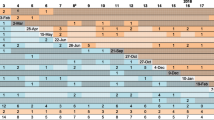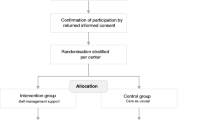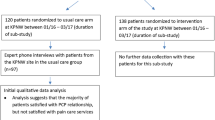Abstract
To describe the design of a telephone follow-up protocol and to evaluate the feasibility of this protocol for advanced cancer pain patients. A series of nine telephone follow-up calls was implemented with 40 advanced cancer pain patients within 3 months after their discharge from the Department of Chemotherapy. Cancer pain information and the pain-related knowledge of the patients were collected by nurses using pain follow-up information sheets and the Patient Pain Questionnaire (PPQ); pain self-efficacy and the quality of life were reported by patients using the Chronic Pain Self-Efficacy Scale (CPSS) Chinese version and the European Organization for Research and Treatment of Cancer Quality of Life Questionnaire-Core 30 (EORTC-QLQ-C30) Chinese version. The average score assessed by advanced cancer pain patients of the need for pain care from nurses was 24.28 (SD = 4.90). Twenty-one and eight patients completed all nine telephone follow-up calls and seven self-reported questionnaires, respectively. The pain intensity of patients at the time of follow-up was mild, but there had been breakthrough pain in the previous week. All patients were satisfied with the nurses’ pain follow-up practices. There was a highly positive correlation between the time of follow-up and the patients’ pain-related knowledge scores (r = 0.963**, p < 0.01). Patients’ pain self-efficacy scores and quality of life scores varied across different dimensions. The baseline pain self-efficacy subscales were associated with all dimensions of quality of life (p < 0.05 or p < 0.01). Telephone follow-up can be an effective method of transitional care. For advanced cancer pain patients, it is still necessary to further explore the cost effectiveness of this method, including the appropriate follow-up duration, endpoints, and outcome measures based on government requirements and policies.


Similar content being viewed by others
References
Van Den Beuken-van Everdingen MH, de Rijke JM, Kessels AG, Schouten HC, van Kleef M, Patijn J (2007) Prevalence of pain in patients with cancer: a systematic review of the past 40 years. Ann Oncol 18:1437–1449
Yu S-Y, Wang J-J, Huang Y-g, Hu B, Wang K, Li PP, Wu Y-L, Zhang H-L, Zhang L, Zhang Q-Y, Qin S-K (2017) Managing pain in patients with cancer: the Chinese good pain management experience. J Glob Oncol 3:583–595
Chiese Nursing Association (2017) Care guidelines for patients with cancer pain (expert consensus). Chinese Nursing Management 17(12):1585–1587
National Heath and Family Planing Commission of People’s Republic of China (2011) Notice of the office of the Ministry of Health on the development of the “standardized treatment demonstration ward of cancer pain”. Retrieved Jan 30, 2015, from http://www.nhfpc.gov.cn/mohyzs/s3586/201104/51234.shtml
Zhou M, Holden L, Bedard G, Zeng L, Lam H, Chu D, Lao N, Lauzon N, Chow E (2012) The utilization of telephone follow-up in the advanced cancer population: a review of the literature. J Comp Eff Res 1(6):509–517
Barnes S (2000) Not a social event: the follow-up phone call. J Perianesth Nurs 15:253–255
Rustoen T, Valeberg BT, Kolstad E, Wist E, Paul S, Miaskowski C (2014) A randomized clinical trial of the efficacy of a self-care intervention to improve cancer pain management. Cancer Nurs 37:34–43
Koller A, Miaskowski C, De Geest S, Opitz O, Spichiger E (2013) Results of a randomized controlled pilot study of a self-management intervention for cancer pain. Eur J Oncol Nurs 17:284–291
Verevkina N, Shi Y, Fuentes-Caceres VA, Scanlon DP (2014) Attrition in chronic disease self-management programs and self-efficacy at enrollment. Health Educ Behav 41:590–598
Yuan-mei Qin, Dong Gou (2010) Pain management knowledge survey of cancer patients and their family members. Chinese Medical News 7:122–124
He H-y (2008) Study on cancer pain self-efficacy, self-efficacy associated factors and its nursing intervention. Third Military Medical University, Chongqing
Romano JM, Jensen MP, Turner JA (2003) The chronic pain coping inventory-42: reliability and validity. Pain 104:65–73
Chong-hua Wang M-QC, Zhang C-z et al (2005) The assessment of EORTC qlq-c30 in Chinese population. J Pract Oncol 20:353–355
EORTC-Quality of Life (1999) Retrieved Nov 2, 2014 from European Organization for Research on Treatment of Cancer. http://qol.eortc.org/questionnaire/eortc-qlq-c30/
Hjermstad MJ, Fossa SD, Bjordal K, Kaasa S (1995) Test/retest study of the European Organization for Research and Treatment of Cancer Core Quality-of-Life Questionnaire. J Clin Oncol 13:1249–1254
Koller A, Gaertner J, Geest SD, Hasemann M, Becker G (2018) Testing the implementation of a pain self-management support intervention for oncology patients in clinical practice. Cancer Nurs 41(5):367–378
Grande GE, Todd CJ (2000) Why are trials in palliative care so difficult? Palliat Med 14(1):69–74
Goebel JR, Sherbourne CD, Asch SM, Meredith L, Cohen AB, Hagenmaier E, Lanto AB, Simon B, Rubenstein LV, Shugarman LR, Lorenz KA (2010) Addressing patients’ concerns about pain management and addiction risks. Pain Manag Nurs 11:92–98
Shu-kui Qin J-JW (2017) Education for pain patients. People’s Medical Publishing House, Beijing
G.-r, Qin (2012) The status and development trend of continuous nursing care for discharged patients. J Nurs Sci 27:89–91
Zhu H-y, L Q-X, Zhao J (2013) Effect of two-way follow-up on patients with moderate and severe cancer pain. J Nurs Sci 19:19–20
Jun-fang F, W D-d, Yu F-f (2014) Meta analysis of the effect of patients’ pain education on alleviating cancer pain. J Nurs Adm 1:20–22
Chen Z-y-y, H X-p, Ju M (2017) Study on self-efficacy and quality of life of cancer pain patients. J Pract Med:636–638
Acknowledgments
The author thanks all the participants for their contributions to the survey.
Funding
The research is approved and supported by a grant from the Nursing Department of Sun Yat-sen University Cancer Center (201305).
Author information
Authors and Affiliations
Corresponding author
Ethics declarations
The study was approved by the ethics committee of our center. Written informed consent was obtained from every participating patient.
Additional information
Publisher’s Note
Springer Nature remains neutral with regard to jurisdictional claims in published maps and institutional affiliations.
Rights and permissions
About this article
Cite this article
Zou, B., Li, X., Huang, X. et al. Telephone Follow-up Design and Practice for Advanced Cancer Pain Patients. J Canc Educ 35, 751–759 (2020). https://doi.org/10.1007/s13187-019-01523-4
Published:
Issue Date:
DOI: https://doi.org/10.1007/s13187-019-01523-4




